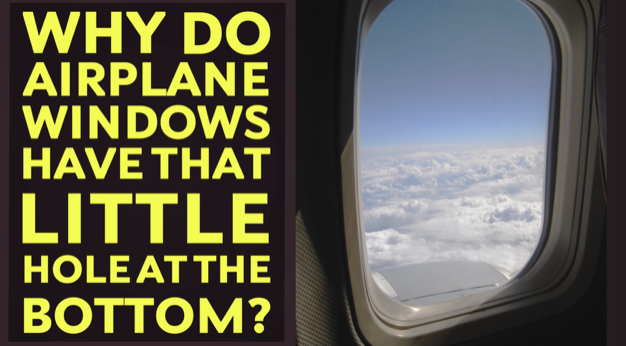
Airline safety is a top priority all throughout the far ranging and complex industry. Most of the safety-related precautions and procedures passengers see are at the gate and in the terminal, but many more less obvious measures are in place. For starters, airplanes have to meet some very strict design and construction guidelines to comply with government regulations and to ensure passenger safety.
After all, when a plane is traveling through the sky, at high speeds, with a full tank of jet fuel, and contending with all sorts of natural hazards like lightning, hail and bird strikes, safety and construction become the number one priority.
All passenger planes must be certified as ‘airworthy’ before any commercial flights on them ever take off. Everything from the engines to the rivets have to be tested and inspected for performance. One design aspect that many people notice, yet tend to overlook, are plane windows.
If you look closely, you can see a tiny hole near the bottom of the pane. Ever wonder why it’s there? I have. Turns out this little hole has a name, it’s called a breather hole, or a bleeder hole, and it’s located on the middle layer of the window.
All airplane windows consist of 3 layers. The part that you can touch when you’re inside the cabin is called the scratch cover and it’s there to protect the real window from being damaged, poked, or destroyed. The middle piece is called the inner pane, which has the hole in it, and then there is the outer pane.
These two panes are both half-inch thick pieces of Plexiglas which are separated by a half an inch of air. The hole allows warm air in-between the inner and outer panes and releases moisture from the air gap, which keeps the window mostly fog and frost free.
The other, more important, function of the hole is to contain and regulate the pressure exerted on the windows. Planes are pressurized during a flight so that people can breathe safely, and the pressure inside the cabin is much greater than the outside air pressure. The outer two cabin panes are designed to contain this difference in pressure and each is strong enough to withstand it on their own.
However, the bleeder hole makes it so that the outer pane bears the pressure. This is because the hole allows the pressure to become balanced between the interior cabin and the air gap between the panes, thus placing the cabin pressure on the outside pane. If the outer pane were to ever fail, the middle one would then take over, instead of the entire window imploding or exploding (which would depend on whatever the pressure differential is).
Turns out that the tiny bleeder hole serves a major purpose. Many of a planes design aspects and inconspicuous, seemingly minor, details serve very important safety functions. It’s no wonder that the airline industry has the best record on file in regards to passenger safety and transportation.
According to Discovery, the odds of a person dying in a plane crash are 1:11 million, whereas the odds of dying in a car accident are 1:5,000. In comparison, the odds of being killed by a shark are 1:3.7 million (National Geographic).
Those odds put it all in perspective, it’s extremely rare to find yourself in an aviation accident, let alone die in one. That is due in part to the breather hole and the many other plane engineering feats that are designed with safety in mind.
Please Share This With Family and Friends










